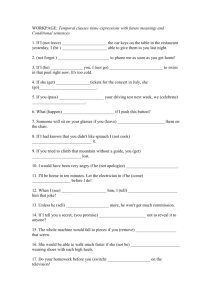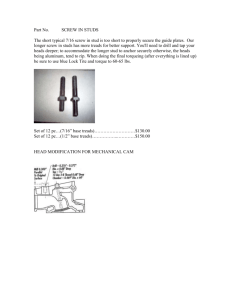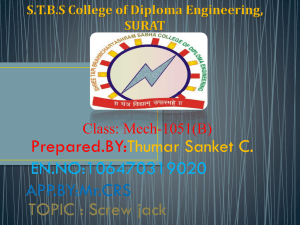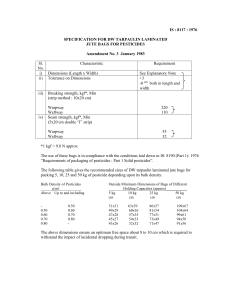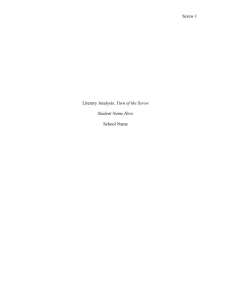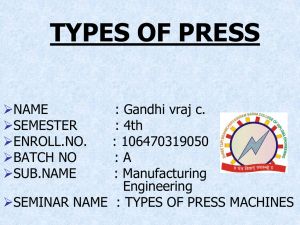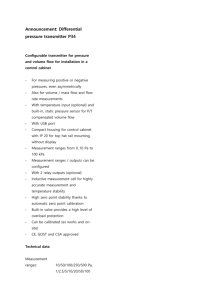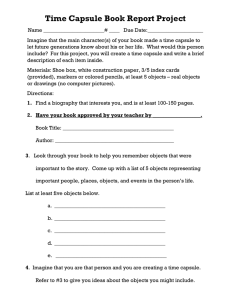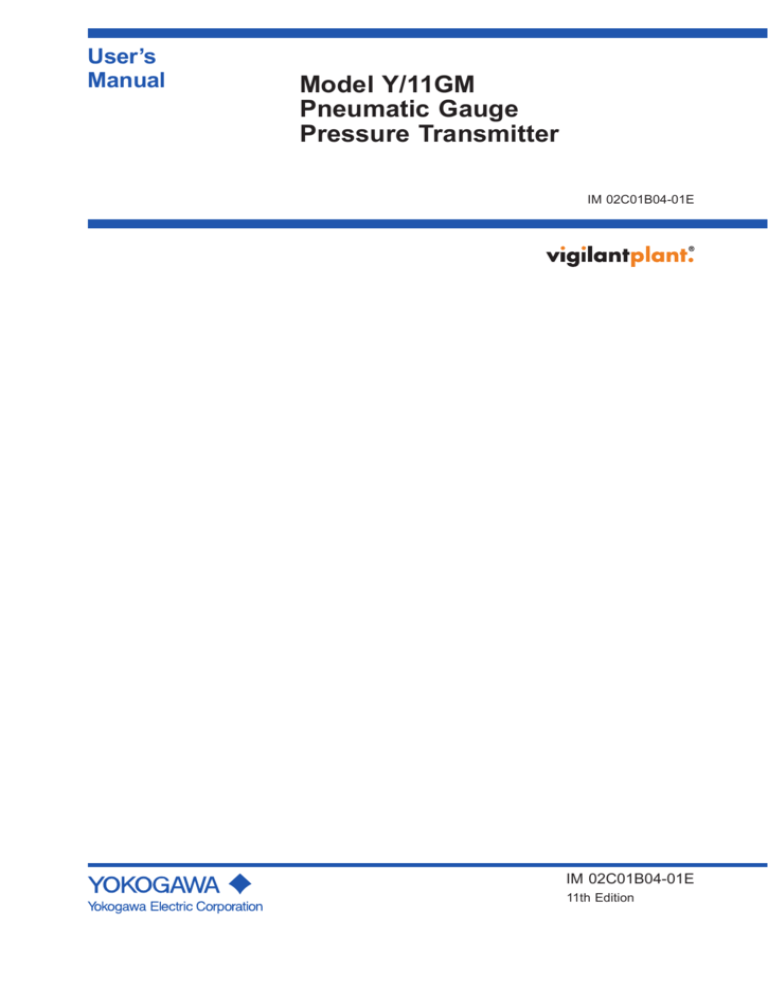
User’s
Manual
Model Y/11GM
Pneumatic Gauge
Pressure Transmitter
IM 02C01B04-01E
IM 02C01B04-01E
11th Edition
i
Model Y/11GM
Pneumatic Gauge
Pressure Transmitter
IM 02C01B04-01E 11th Edition
CONTENTS
1.
2.
3.
4.
Introduction................................................................................................ 1-1
1.1
Safety Precautions............................................................................................. 1-2
1.2
Warranty.............................................................................................................. 1-2
General....................................................................................................... 2-1
2.1
Outline................................................................................................................. 2-1
2.2
Principle of Operation....................................................................................... 2-1
2.3
Standard Specifications.................................................................................... 2-2
2.4
Model and Suffix Codes.................................................................................... 2-3
2.5
Options................................................................................................................ 2-3
2.6
Dimensions......................................................................................................... 2-4
Installation.................................................................................................. 3-1
3.1
Transmitter Mounting........................................................................................ 3-1
3.2
Typical Transmitter Piping................................................................................ 3-1
3.3
Air Supply and Transmission Piping............................................................... 3-1
Operation.................................................................................................... 4-1
4.1
5.
Zero Adjustment................................................................................................. 4-1
4.1.1 WITHOUT Elevated or Suppressed Zero Range............................... 4-1
4.1.2 WITH Elevated or Suppressed Zero Range....................................... 4-1
Maintenance............................................................................................... 5-1
5.1
Calibration Notes............................................................................................... 5-1
5.1.1
Calibration Equipment........................................................................ 5-1
5.1.2
Calibration Procedure......................................................................... 5-1
5.1.3
To Change Range of Transmitter........................................................ 5-2
5.1.4
Flexure Cap Screw Adjustment.......................................................... 5-3
5.1.5
Overrange Stop Adjustment............................................................... 5-3
5.2
Supply Air Filter.................................................................................................. 5-4
5.3
To Clean Restrictor............................................................................................ 5-4
5.4
To Clean Nozzle Assembly................................................................................ 5-4
5.5
To Remove Bellows Capsule............................................................................ 5-5
5.6
To Replace Bellows Capsule............................................................................ 5-5
5.7
To Clean or Replace Screens............................................................................ 5-5
5.8
To Remove Pneumatic Amplifier...................................................................... 5-5
11th Edition: Feb. 2013 (KP)
All Rights Reserved, Copyright © 1982, Yokogawa Electric Corporation
IM 02C01B04-01E
ii
5.9
Further Disassembly......................................................................................... 5-6
5.9.1
Dashpot Removal............................................................................... 5-6
5.9.2
Dashpot Alignment.............................................................................. 5-6
5.9.3
To Remove Feedback Bellows and Zero Spring
(behind Zero Screw)........................................................................... 5-6
5.9.4
To Remove Back Flexures.................................................................. 5-7
5.9.5
To Remove Force Balance Unit.......................................................... 5-7
5.9.6
To Remove Relay Mounting Assembly............................................... 5-7
5.9.7
To Remove Front Flexure................................................................... 5-7
5.9.8
To Remove Force Bar......................................................................... 5-8
5.9.9
Flapper Alignment............................................................................... 5-8
5.9.10
Bolt Tightening Procedure - Force Balance Unit................................ 5-9
Appendix 1. 80A Pneumatic Amplifier (Part No. F9138YA)..........................A-1
A1.1
Principles of Operation.................................................................................... A-1
A1.2
Cleaning the Pneumatic Amplifier.................................................................. A-1
A1.3 Calibration Procedure using Calibrating Fixture.......................................... A-2
Customer Maintenance Parts List
Model Y/11GM PNEUMATIC GAUGE PRESSURE
TRANSMITTER (Style C).................................................................... CMPL 02C01B04-01E
IM 02C01B04-01E
1.
1-1
<1. Introduction>
Introduction
Thank you for purchasing the Yokogawa’s
instrument.
The instrument is correctly calibrated at the factory
before shipment. To ensure correct and efficient
use of the instrument, please read this manual
thoroughly and fully understand how to operate the
instrument before operating it.
Regarding This Manual
• This manual should be provided to the end
user.
• The contents of this manual are subject to
change without prior notice.
• All rights reserved. No part of this manual may
be reproduced in any form without Yokogawa’s
written permission.
• Yokogawa makes no warranty of any kind with
regard to this material, including, but not limited
to, implied warranty of merchantability and
fitness for a particular purpose.
• If any question arises or errors are found, or if
any information is missing from this manual,
please inform the nearest Yokogawa sales
office.
• The specifications covered by this manual are
limited to those for the standard type under the
specified model number break-down and do not
cover custom-made instrument.
• Please note that changes in the specifications,
construction, or component parts of the
instrument may not immediately be reflected
in this manual at the time of change, provided
that postponement of revisions will not cause
difficulty to the user from a functional or
performance standpoint.
Safety Precautions
• For the protection and safety of the operator
and the instrument or the system including
the instrument, please be sure to follow the
instructions on safety described in this manual
when handling this instrument. In case the
instrument is handled in contradiction to these
instructions, Yokogawa does not guarantee
safety.
• Yokogawa assumes no responsibilities for this
product except as stated in the warranty.
• If the customer or any third party is harmed by
the use of this product, Yokogawa assumes
no responsibility for any such harm owing to
any defects in the product which were not
predictable, or for any indirect damages.
• The following safety symbols are used in this
manual:
WARNING
Indicates a potentially hazardous situation which,
if not avoided, could result in death or serious
injury.
CAUTION
Indicates a potentially hazardous situation which,
if not avoided, may result in minor or moderate
injury. It may also be used to alert against unsafe
practices.
IMPORTANT
Indicates that operating the hardware or software
in this manner may damage it or lead to system
failure.
NOTE
Draws attention to information essential for
understanding the operation and features.
IM 02C01B04-01E
1.1 Safety Precautions
WARNING
• Instrument installed in the process is under
pressure. Never loosen or tighten the
process connector bolts as it may cause
dangerous spouting of process fluid.
• During draining condensate or venting gas
in transmitter pressure-detector section, take
appropriate care to avoid contact with the
skin, eyes or body, or inhalation of vapors, if
the accumulated process fluid may be toxic
or otherwise harmful.
Since draining condensate or bleeding
off gas gives the pressure measurement
disturbance, this should not be done when
the loop is in operation.
• If the accumulated process fluid may be
toxic or otherwise harmful, take appropriate
care to avoid contact with the body, or
inhalation of vapors even after dismounting
the instrument from process line for
maintenance.
IMPORTANT
• Supply air must be clean and dry.
- Supply air (pressurized) must not be
dewed event at -40°C.
- Air filter with 5μm (0.0002 inch) of filter
element maximum opening shall be
recommended.
- Oil filter should be provided to remove oil
in the supply air.
• Maximum supply air pressure of transmitter
without fixed pressure regulator (GAS or
NAS type) is 215 kPa. Should the pressure
exceed 215 kPa, it is possible to break the
pneumatic amplifier, bellows etc.
• When weling piping during construction, take
care not to allow welding currents to flow
through the transmitter.
• Do not step on this instrument after
installation.
• Applying a leakag-detecting fluid to the
instrument may damage the plastic parts
resulting from corrosion or cracking.
<1. Introduction>
1-2
1.2 Warranty
The warranty shall cover the period noted on
the quotation presented to the purchaser at the
time of purchase. Problems occurred during the
warranty period shall basically be repaired free
of charge.
• In case of problems, the customer should
contact the Yokogawa representative from
which the instrument was purchased, or the
nearest Yokogawa office.
• If a problem arises with this instrument,
please inform us of the nature of the problem
and the circumstances under which it
developed, including the model specification
and serial number. Any diagrams, data and
other information you can include in your
communication will also be helpful.
• Responsible party for repair cost for the
problems shall be determined by Yokogawa
based on our investigation.
The Purchaser shall bear the responsibility for
repair costs, even during the warranty period, if
the malfunction is due to:
• Improper and/or inadequate maintenance by
the Purchaser.
• Failure or damage due to improper handling,
use or storage which is out of design
conditions.
• Use of the product in question in a location
not conforming to the standards specified
by the Yokogawa, or due to improper
maintenance of the installation location.
• Failure or damage due to modification or
repair by the party except Yokogawa or who
is requested by Yokogawa.
• Malfunction or damage from improper
relocation of the product in question after
delivery.
• Reason of force majeure such as fires,
earthquakes, storms/floods, thunder/
lightening, or other natural disasters, or
disturbances, riots, warfare, or radioactive
contamination.
IM 02C01B04-01E
2.
2-1
<2. General>
General
2.1 Outline
Model Y/11GM Pressure Transmitter is a forcebalance instrument that measures pressure and
transmits it as a proportional 0.2 to 1.0 kgf/cm2 or
bar, 20 to 100 kPa, or 3 to 15 psi pneumatic signal.
Reducing tube
Flapper nozzle
assembly
Air supply
Pneumatic
Amplifier
Output
Flexure connector
Force bar
Diaphragm seal
Range wheel
Range bar
Feedback
bellows
Zero
adjustment
screw
Pressure
connection
F0201.ai
Figure 2.1
Bellows
capsule
Outline
2.2 Principle of Operation
Flexure
Figure 2.2 F0202.ai
Principle of Operation
The pressure being measured is applied to a
bellows capsule. The force on the capsule is
transmitted through a flexure to the lower end of
the force bar. The metal diaphragm seal serves as
both a fulcrum for the force bar and as a seal for the
pressure chamber. The force is transmitted through
the flexure connector to the range bar which pivots
on the range wheel.
Any movement of the range bar causes a minute
change in the clearance between the flapper and
nozzle. This produces a change in the output
pressure from the amplifier to the feedback bellows
until the force on the feedback bellows balances the
force on the bellows capsule.
The output pressure which is established by this
force balance is the transmitted signal and is
proportional to the pressure applied to the bellows
capsule. This signal is transmitted to a pneumatic
receiver to record, indicate and/or control.
IM 02C01B04-01E
2-2
<2. General>
2.3 Standard Specifications
Process Temperature Limits:
-40 and 120 °C (-40 and 250 °F) at capsule.
Mounting:
Bracket for nominal 50 mm (2 inches) horizontal or
vertical pipe.
Air Connection:
Tapped for JIS R1/4 or 1/4 NPT, whichever
specified.
Process Connections:
JIS Rc1/2, Rc1/4, 1/2 NPT, or 1/4 NPT female,
whichever specified.
Wetted Parts Material:
Process Connection Block: Forged JIS SUS 316
stainless steel.
Bellows Capsule: SUS 316L stainless steel.
Capsule Gaskets: Silicone elastomer.
Body Material:
Forged SUS 316 stainless steel. Not wetted by
process.
Connection Hardware:
JIS SCM435 chrome-molybdenum steel cap
screws and nuts through body and process
connection block.
Cover:
Cast aluminum, finished with gray polyurethane
paint. Gasketed for National Electrical
Manufacturers Association (NEMA) (USA) Type 3
weatherproof service.
Approximate Weight:
5.3 kg (12 lb).
Span Limits:
Refer to Table 2.1.
Span is continuously adjustable within range
limits.
Range Limits *:
Refer to Table 2.1.
*:when lower range-value is other than zero,
optional kit for elevated-zero or suppressedzero ranges is installed.
Overpressure Limits:
Refer to Table 2.1.
Output Signal:
20 to 100 kPa.
Accuracy (includes linearity, hysteresis and
repeatability):
±0.5 % of span.
Repeatability:
0.1 % of span.
Dead Band:
0.05 % of span.
Air Supply Pressure:
140 kPa, 1.4 kgf/cm2 or bar, or 20 psi.
Air Consumption:
0.5 m3/h at 0 °C, 101.3 kPa {1.033 kgf/cm2}
absolute (0.3 scfm).
Ambient Operating Temperature Range:
-40 to 120 °C (-40 to 250 °F).
Table 2.1. Span, Range and Overpressure Limits.
Capsule
A
B
C
D
E
Span Limits
Range Limits
O. P. Limits
Span Limits
Range Limits
O. P. Limits
Span Limits
Range Limits
O. P. Limits
Span Limits
Range Limits
O. P. Limits
Span Limits
Range Limits
O. P. Limits
Output Signal
Option Code
–
M-calibration
P-calibration
bar-calibration
0.07 to 0.55 MPa
-0.1 to 0.6 MPa
0.7 MPa
0.14 to 1.4 MPa
-0.1 to 2.4 MPa
3.5 MPa
0.28 to 2.7 MPa
-0.1 to 5.1 MPa
7 MPa
0.7 to 6.8 MPa
-0.1 to 10 MPa
14 MPa
1.4 to 13.7 MPa
-0.1 to 20 MPa
28 MPa
20 to 100 kPa
Standard
Specifications
0.7 to 5.6 kgf/cm2
-1 to 6 kgf/cm2
7 kgf/cm2
1.4 to 14 kgf/cm2
-1 to 24 kgf/cm2
35 kgf/cm2
2.8 to 28 kgf/cm2
-1 to 52 kgf/cm2
70 kgf/cm2
7 to 70 kgf/cm2
-1 to 105 kgf/cm2
140 kgf/cm2
14 to 140 kgf/cm2
-1 to 210 kgf/cm2
280 kgf/cm2
0.2 to 1.0 kgf/cm2
10 to 80 psi
-50 to 90 psi
100 psi
20 to 200 psi
-15 to 350 psi
500 psi
40 to 400 psi
-15 to 750 psi
1000 psi
100 to 1000 psi
-15 to 1500 psi
2000 psi
200 to 2000 psi
-15 to 3000 psi
4000 psi
3 to 15 psi
0.7 to 5.5 bar
-1 to 6 bar
7 bar
1.4 to 14 bar
-1 to 24 bar
35 bar
2.8 to 27 bar
-1 to 51 bar
70 bar
7 to 68 bar
-1 to 100 bar
140 bar
14 to 137 bar
-1 to 200 bar
280 bar
0.2 to 1.0 bar
CAL-M
CAL-E
CAL-B
IM 02C01B04-01E
2-3
<2. General>
2.4 Model and Suffix Codes
Model
Suffix Codes
Description
Y/11GM
..............
Pneumatic gauge
pressure transmitter.
A capsule.
Span:0.07 to 0.55 MPa
B capsule.
Span:0.14 to 1.4 MPa
C capsule.
Span:0.28 to 2.7 MPa
D capsule.
Span:0.7 to 6.8 MPa
E capsule.
Span:1.4 to 13.7 MPa
-A . . . . . . . . . . . . .
-B . . . . . . . . . . . . .
Bellows -C . . . . . . . . . . . . .
Capsule
-D . . . . . . . . . . . . .
-E . . . . . . . . . . . . .
Body
Material *1
Process
Connection
S . . . . . . . . . . Forged JIS SUS 316
stainless steel.
1 . . . . . . . .
2 . . . . . . . .
3 *2 . . . . . . .
4 *2 . . . . . . .
8 . . . . . . . .
Options
/
JIS Rc 1/4 female.
JIS Rc 1/2 female.
ANSI 1/4 NPT female.
ANSI 1/2 NPT female.
Diaphragm sealed
transmitter.(Refer to
GS 06P01D01-00E)
/
*1: Users must consider the characteristics of
selected wetted parts material and the influence
of process fluids. The use of inappropriate
materials can result in the leakage of corrosive
process fluids and cause injury to personnel and/
or damage to plant facilities. It is also possible that
the diaphragm itself can be damaged and that
material from the broken diaphragm and the fill
fluid can contaminate the user’s process fluids.
Be very careful with highly corrosive process
fluids such as hydrochloric acid, sulfuric acid,
hydrogen sulfide, sodium hypochlorite, and hightemperature steam (150 ºC [302 ºF] or above).
Contact Yokogawa for detailed information of the
wetted parts material.
*2: Air connections are also tapped for ANSI NPT threads in
addition to the process connection.
2.5 Options
Air Set:
Fixed combination pressure regulator and filter
with 35 mm diameter pressure gauge mounted
and piped to transmitter. Also available without
gauge.
Supply pressure: 0.2 to 1 MPa, 2 to 10 kgf/cm2
or bar, or 30 to 150 psi.
Output pressure: 140 kPa, 1.4 kgf/cm2 or bar, or
20 psi.
Maximum operating temperature: 80 °C (180
°F).
Air Connection
Gauge Scale
Option Code
JIS Rc 1/4
female
0 to 200 kPa
0 to 2 kgf/cm2
0 to 30 psi
0 to 2 bar
Without gauge
GAS-FP
GAS-FM
GAS-FE
GAS-FB
GAS-F
1/4 NPT female
0 to 200 kPa
0 to 2 kgf/cm2
0 to 30 psi
0 to 2 bar
Without gauge
NAS-FP
NAS-FM
NAS-FE
NAS-FB
NAS-F
Kit for Elevated-Zero or Suppressed-Zero
Ranges:
Permits adjustments to 1000 % of minimum span
and to range limits of capsule. Upper range-value
must not exceed upper range-limit of capsule.
Option code: R-kit for suppressed-zero ranges
and L-kit for elevated-zero ranges.
Low Spans:
Refer to Table 2.2. Accuracy ±0.5 % of span.
(Add 0.5 % with Suffix Code R or L)
Option code: LD.
Cover Color Other Than Standard Finish:
Specify in color block □ by color code. Refer to
GS 22D1F1-E.
Option code: SCF-□.
Stainless Steel Hardware:
JIS SUS 630 cap screws and nuts through body
and process connection block.
Option code: SSB.
Oxygen Service Preparation:
Degrease cleansing treatment.
Option code: OSW.
ANSI connection:
For diaphragm sealed transmitter with ANSI
process flange, air connections with tapped for
ANSI NPT threads. Option code: NPT
Calibration Units:
M-calibration (Unit: kgf/cm2) Option code: CAL-M
P-calibration (Unit: psi)
Option code: CAL-E
bar-calibration (Unit: bar)
Option code: CAL-B
Table 2.2. Low Spans
Capsule
Span
kPa
kgf/cm2
psi
A
35 to 270
0.35 to 2.8
5 to 40
B
70 to 700
0.7 to 7
10 to 100
C
140 to 1350
1.4 to 14
20 to 200
D
350 to 3400
3.5 to 35
E
700 to 6800
7 to 70
50 to 500
100 to 1000
IM 02C01B04-01E
2-4
<2. General>
2.6 Dimensions
Unit : mm
Allow clearance 150 mm
for cover removal
118
110
25.4
Air supply connection
(without air supply set)
Output connection
Air supply set
(option)
193
Air supply gauge
(option)
Allow clearance
150 mm for zero
adjustment
SUP OUT
65
370
34
Process connection
130
Air supply connection
(with air supply set)
* 59
Nominal 50 mm (2 inches) pipe
vertical or horizontal
(supplied by user)
68
94
* 73 mm when A capsule.
93
51
127
F0203.ai
IM 02C01B04-01E
3.
Installation
3.1 Transmitter Mounting
(2) Transmitter below Level of Pressure Tap
A
Transmitter may be mounted in any position.
After transmitter is mounted, tighten all bolts.
Pipe may be clamped to another pipe, or flanged
and bolted to floor or wall.
U-bolt secures assembly to 2" (nominal 50 mm)
pipe. U-bolt may be revolved 90° for use with
horizontal pipe.
Optional air-set can be mounted as illustrated
below.
B
Pipe or tank
C
2-inch pipe support
Either set of
mounting holes
may be used.
Bolt
For fixed regulator and
associated parts, refer to
Customer Maintenance
Parts List involved.
Figure 3.1 3-1
<3. Installation>
U-Bolt
2" Pipe
F0301.ai
Transmitter Mounting
3.2 Typical Transmitter Piping
Figure 3.2 Typical Transmitter Piping
When zeroing transmitter (Refer to section 4.1),
close valve A and open plug B, or insert a test
gauge at B to read applied pressure and adjust
output to appropriate value. When transmitter is
located below pressure tap, use valve C as a drain,
or as a filling valve for seal fluid.
3.3 Air Supply and Transmission
Piping
Receiver
Transmitter
(1) Transmitter at Level of Pressure Tap
B
F0303.ai
1/4" (8A) tubing
A
Output gauge
Supply gauge
Pipe or tank
Air supply
Air filter-regulator (optional)
2-inch pipe support
F0302.ai
Figure 3.3 F0304.ai
Air Supply and Transmission Piping
NOTE
• Air supply must be regulated at 1.4 kgf/cm2 or
bar, 140 kPa, or 20 psi.
• Transmitter uses 0.5 Nm3/h of air in normal
operation.
• Air must be clean and dry. Blow out filter
regularly.
• Transmission line must be free of leaks.
IM 02C01B04-01E
4.
4-1
<4. Operation>
Operation
4.1 Zero Adjustment
Test gauge
4.1.1 WITHOUT Elevated or Suppressed
Zero Range
Make zero adjustment with transmitter in operating
position.
1. Adjust air supply to pressure at which
transmitter will operate.
2. Vent pressure connection. On liquid filled
system, vent at level of pressure tap.
3. Connect a 0-1.5 kgf/cm2 or bar, 0-150 kPa, or
0-22 psi test gauge (or manometer) to OUT
connection.
4. Adjust zero screw for a 0.2 kgf/cm2 or bar, 20
kPa, or 3 psi output.
5. Disconnect test gauge and reconnect receiver.
If necessary, change zero adjustment on
receiver so that reading is zero.
OUT connection
Test gauge
Air supply
(140 kPa)
Pressure connection
F0403.ai
3. Adjust pressure to some value between 0.2 and
1.0 kgf/cm2 or bar, 20 and 100 kPa, or 3 and
15 psi. Using formula below, calculate output
corresponding to this pressure.
4. Adjust zero elevation or zero suppression screw
so that output is approximately the calculated
value.
Adjust zero screw so that output is exactly at
the calculated value.
If necessary, change zero adjustment on
receiver so that reading is calculated value.
With zero elevation
kit, screw is on
opposite side.
Zero elevation or
zero suppression
screw
Zero screw
F0401.ai
F0404.ai
Zero screw
F0402.ai
Figure 4.1
Zero Adjustment
4.1.2 WITH Elevated or Suppressed Zero
Range
Make zero adjustment with transmitter in operating
position.
1. Set up equipment as shown above, but do not
vent pressure to atmosphere.
2. Insert test gauge in measurement line. For
liquid filled systems, insert gauge at level of
pressure tap.
Figure 4.2
Zero Adjustment
Formula to Calculate Output for Transmitter with
0.2-1.0 kgf/cm2 Output
Output =
Test gauge reading – Lower range limit
(0.8)
+ 0.2
Upper range limit – Lower range limit
Example:Instrument Range, 10-14 kgf/cm2
Test gauge reading, 11 kgf/cm2
Output = (0.8)
11 – 10
14 – 10
+ 0.2 = 0.4 kgf/cm2
Note: With 20 to 100 kPa or 3 to 15 psi output, substitute 20 and
80 or 3 and 12 for 0.2 and 0.8 respectively, in the equation
above.
IM 02C01B04-01E
5.
5-1
<5. Maintenance>
Maintenance
5.1 Calibration Notes
5.1.2 Calibration Procedure
Calibration is required if the transmitter has been
taken apart for cleaning or for parts replacement,
if a change of range is desired, or if the amount of
zero elevation or zero suppression (if transmitter is
so equipped) is changed substantially.
Step 2, 4 and 5 in procedure below pertain only
to transmitters with elevated or suppressed zero
ranges. Illustrations for these steps show zero
suppression kit. If transmitter has zero elevation
kit, location of the 2 screws mentioned is reversed.
If transmitter has neither elevated nor suppressed
zero range, skip these steps.
1. Set up calibration equipment (Refer to section
5.1.1).
Check overrange stop adjustment (Refer to
section 5.1.5).
2. If transmitter has elevated or suppressed zero
range, disconnect spring from force bar as
follows.
If the capsule was removed or the flexure cap screw
loosened, before calibrating, make the flexure cap
screw adjustment.
The transmitter may be calibrated to 0.2-1.0 kgf/
cm2, 20-100 kPa, 0.2-1.0 bar, or 3-15 psi signal
pressure range. These four ranges are not exactly
equivalent; therefore the transmitter must be
calibrated to the same signal pressure range as the
receiver with which it is used.
5.1.1 Calibration Equipment
A. Remove screw from end of spring.
Bracket
Pneumatic
0-1.5 kgf/cm2 or bar, 0-150 kPa, or
0-22 psi Test gauge (or manometer)
Vacuum
B. Turn adjustment screw clockwise
until spring is clear of bracket.
Spring must not bind against
flapper or casting.
A
F0503.ai
B
Pressure
F0501.ai
Lock in desired pressure or vacuum with valve A.
Reduce by bleeding at B.
3. With no pressure on transmitter, adjust zero
screw so that output on test gauge reads 0.2
kgf/cm2 or bar, 20 kPa, or 3 psi.
If screw was removed in Step 2-A, replace it.
Hydraulic
(required with high pressures)
Weights
Dead
weight
tester
Zero screw
F0502.ai
Increase pressure with crank until pressure
supports an accurately-known weight. Accurate test
gauge may be used with hydraulic pump in a similar
set up.
Figure 5.1
F0504.ai
Calibration Equipment
IM 02C01B04-01E
5-2
<5. Maintenance>
4. With elevated or suppressed zero range, set
calibrating pressure equal to lower limit.
Calibrating
pressure
F0505.ai
5. Turn adjustment screw so that output is 0.2 kgf/
cm2 or bar, 20 kPa, or 3 psi.
Adjustment
screw
F0506.ai
6. Set calibrating pressure equal to upper limit.
The output should be 1.0 kgf/cm2 or bar, 100
kPa, or 15 psi.
7. If output is incorrect, loosen locknut and adjust
range wheel for correct output. Turning range
wheel down increases output. Retighten locknut
after each adjustment.
NOTE
An optional spring attachment permits the range
to be elevated zero or suppressed zero. The sum
of zero suppression plus span must not exceed
the upper range limit of the capsule. The amount
of zero elevation must not exceed – 1.0 kgf/cm2 or
bar, – 100 kPa, or 15 psi.
5.1.3 To Change Range of Transmitter
The transmitter range may be changed to any value
within the limits of the capsule by changing the
span and zero adjustments. If the desired range
is outside the limits of the capsule installed in the
transmitter, a different capsule is required. (If the
capsule is changed, and “A” capsule is involved, a
different connection block and capsule O-ring are
required. Refer to Customer Maintenance Parts List
CMPL 02C01B04-01E for further details.)
Refer to section 2.3 (Table 2.1) for range, span, and
overrange limits for the various capsules.
■ Capsule Identification
Capsule is identified by designation (A, B, C, D and
E) stamped on face, or by dimension indicated.
d
Range wheel
Locknut
F0508.ai
F0507.ai
8. Repeat Steps 3 through 7 until the desired
accuracy is obtained. Tighten range wheel
locknut securely.
9. Make zero adjustment (Refer to section 4.1).
Dimension d (mm)
Capsule
19
A
13
B
10
C
6
D
4
E
Figure 5.2
Capsule Identification
IM 02C01B04-01E
5-3
<5. Maintenance>
5.1.4 Flexure Cap Screw Adjustment
5.1.5 Overrange Stop Adjustment
This adjustment should be made if the capsule has
been replaced, or the cap screw loosened.
1. Set up calibration equipment (Refer to section
5.1.1).
2. Disconnect zero elevation or zero suppression
attachment as discribed in Step 2 of Calibration,
(Refer to section 5.1.2).
3. Vent pressure connection to the transmitter.
4. Loosen flexure locknut using 9/64" hex-key
wrench.
5. With no pressure on transmitter, adjust zero
screw for 0.2 kgf/cm2 or bar, 20 kPa, or 3 psi
output.
6. Carefully tighten flexure cap screw and observe
output.
If output change is less than 0.014 kgf/cm2 or
bar, 1.4 kPa, 0.2 psi, readjust zero screw to
bring output to 0.2 kgf/cm2 or bar, 20 kPa, or 3
psi.
If output change is greater than 0.014 kgf/cm2
or bar, 1.4 kPa, or 0.2 psi, repeat Steps 4, 5 and
6. If change persists, check capsule installation
(Reter to section 5.6), then repeat Flexure Cap
Screw Adjustment.
7. Calibrate transmitter.
The overrange stop prevents damage to both the
flapper-nozzle and the dashpot. Before calibrating,
check that the stop is correctly adjusted.
IMPORTANT
Do not move the force bar if the overrange stop is
loose or disconnected.
1. Turn on air supply. Apply pressure to transmitter
so that output is stabilized at a value between
0.2 and 1.0 kgf/cm2 or bar, 20 and 100 kPa, or 3
and 15 psi.
2. Clearance between both sides of overrange
stop (U-shaped bracket) and plate to be
sufficient to permit sliding piece of paper
between them.
3. If not, loosen screws with 3/32" hex-key wrench
and reposition stop to get correct clearance.
Retighten screws.
Overrange stop
Screw
Zero screw
F0510.ai
Hex-key wrench
Figure 5.3
Flexure Cap Screw Adjustment
F0509.ai
4. With zero elevation kit, loosen lockscrew with
3/32" hex-key wrench. Hold eccentric pin in
correct position with open-end wrench and
tighten lockscrew.
Overrange stop
4.
Instrument
with Zero Elevation Kit
Instrument
with Zero Suppression Kit
F0511.ai
IM 02C01B04-01E
5.2 Supply Air Filter
5.4 To Clean Nozzle Assembly
An accumulation of dirt at the flapper nozzle may
cause a zero shift.
1. Unscrew nozzle nut. Do not let soldered nut on
opposite side of casting turn.
2. Ease nozzle out of casting.
3. Loosen clamp screw and rotate S-clamp.
Withdraw nozzle O-ring connection with twisting
motion. Do not bend tubing.
4. Clean nozzle with 0.73 mm dia. wire,
compressed air, or suitable solvent. Wipe top of
flapper clean.
F0512.ai
Wire
Blow filter out at least once a day.
Figure 5.4
5-4
<5. Maintenance>
Air Filter
5.3 To Clean Restrictor
A plugged restrictor will cause low output pressure.
1. Remove pneumatic amplifier (Refer to section
5.8)
2. Lift out restrictor with tweezers.
3. Clean with a 0.18 mm dia. wire
4. Apply thin film of Vaseline, or similar lubricant to
O-ring.
O-ring
F0514.ai
5. Before replacing, apply a thin film of Vaseline
or similar lubricant to O-ring. Replace nozzle
assembly in reverse order. Check reference
adjustment (Refer to section 4.1).
Amplifier
Nozzle nut
Nozzle
assembly
Tweezers
Nozzle
Wire
Before August. 1975, restrictor was
screwed into side of casting.
O-ring
Clamp screw
F0513.ai
Figure 5.5
Cleaning of Restrictor
Feedback O-ring
connection
Nozzle O-ring
connection
Figure 5.6
F0515.ai
Cleaning of Nozzle Assembly
IM 02C01B04-01E
5-5
<5. Maintenance>
5.5 To Remove Bellows Capsule
1. Insert 9/64" hex-key wrench in opening and
loosen, but do not remove flexure cap screw.
Refer to Figure 5.8.
2. Remove the 2 body nuts and lift off pressure
connection block from transmitter.
Do not remove bolts.
3. Lift out capsule.
Do not bend flexure.
Force bar
Flexure
Washer
Cap screw
9/64" wrench
F0518.ai
Figure 5.8
Connection
block
Capsule
Replace the Bellows Capsule.
5.7 To Clean or Replace Screens
Hex-key
wrench
F0516.ai
Figure 5.7
Remove Bellows Capsule
If fine screen air filters
become clogged,
remove with pointed
tool and replace.
5.6 To Replace Bellows Capsule
When capsule is replaced, use new O-rings.
1. Lubricate O-rings with a thin film of Vaseline or
similar lubricant. Position larger ring in recess in
body and smaller ring over shoulder of capsule.
2. Insert capsule with flexure horizontal against
bottom of force bar.
3. Loosely screw cap screw into force bar to clamp
flexure lightly.
4. Position connection block over bolts and tighten
nuts gradually to 55 N·m torque.
5. Tighten flexure against bottom of force bar as
described in Flexure Cap Screw Adjustment
(Refer to section 5.1.4), then calibrate
transmitter (Refer to section 5.1.2).
O-ring
Connection block
Remove coarse screen
filter with pointed tool
for cleaning or replacement.
F0519.ai
Figure 5.9
Clean or Replace Screens
5.8 To Remove Pneumatic
Amplifier
To remove pneumatic amplifier, remove 2 large
screws and pry off. A gasket is furnished with each
replacement amplifier.
When replace the pneumatic amplifier, tighten the
screws by the torque of 1.6 to 1.8 N·m (16 to 18
kgf·m).
For servicing details, refer to Appendix 1.
Screw
Capsule identification
is stamped on face.
F0517.ai
F0520.ai
Figure 5.10 Remove Pneumatic Amplifier
IM 02C01B04-01E
5-6
<5. Maintenance>
5.9 Further Disassembly
5.9.2 Dashpot Alignment
IMPORTANT
Normal servicing of the transmitter does not
require the removal of any parts other than those
already mentioned. Further disassembly is not
recommended by YOKOGAWA. The following
procedures are described for emergency use only
and the user must assume responsibility for loss of
accuracy or damage to the transmitter.
1. With air supply on, there must be some output
from transmitter.
2. Loosen flexure locking screw 26 just enough
to allow free vibration of adjacent parts. Put
a finger on dashpot nut 31 and gently move
dashpot assembly back and forth (total travel is
about 1 mm) in line of flexure. When assembly
is in middle of its travel, tighten flexure locking
screw 26 . Flexure 25 must be flat and horizontal.
20
19
Dashpot nut 31
25 Dashpot flexure
Dashpot 30
26 Flexure locking
21
1
2
3
4
18
Dashpot
29
clamp
5
screw
27
Flexure mounting
bracket
28 Dashpot clamp
screws
Parts associated with
servicing of dashpot.
F0521.ai
5.9.1 Dashpot Removal
1. Remove flexure locking screw 26 , and loosen
the two dashpot clamp screws 28 . Lift out
dashpot assembly. Disconnect flexure 25 by
unscrewing dashpot nut 31 .
Caution: In removing and replacing dashpot nut, keep dashpot
30 from turning by putting a thin, open-end wrench
across flat sections of dashpot just under flexure.
2. To replace assembly, position narrow slotted
hole of flexure on dashpot stud. Put washer
on stud and loosely screw on nut 31 . Slide
dashpot into clamp. Position flexure laterally
so that slotted hole in free end is approximately
centered on tapped hole under it. Tighten nut
31 .
3. Adjust height of dashpot until free end of flexure
just touches flexure mounting bracket 27 .
Tighten the two clamp screws 28 . Loosely insert
flexure locking screw 26 and its washer in place.
17
16
15
6
7
14
8
12
13
9
11
10
F0522.ai
5.9.3 To Remove Feedback Bellows and
Zero Spring (behind Zero Screw)
1. Carefully pry out feedback O-ring connection at
amplifier (Refer to section 5.4).
2. Using 7/16" open-end wrench, remove the two
1/4" cap screws 12 holding bracket 11 .
3. Unscrew completely zero adjustment screw 13
to release zero spring. Bracket 11 and feedback
bellows 15 can now be removed.
4. Remove nut 14 to disconnect feedback bellows
from bracket.
5. Remove zero spring by unscrewing it from
range bar 16 . Be careful not to change
alignment on the spring clamp.
6. Reverse this procedure to reassemble, making
sure that post on bracket is within zero spring
alignment clamp. Tighten zero adjustment
screw until about 6 mm of thread remains
exposed. When replacing feedback connection,
apply a thin film of Vaseline or similar lubricant
to O-ring.
7. Check calibration (Refer to section 5.1.2).
IM 02C01B04-01E
5.9.4 To Remove Back Flexures
Unless front flexure 6 has already been removed,
7/64" hex-key wrench used in Step 2 must be cut
down to fit into screws 20 .
1. Using 7/16" open-end wrench, remove 1/4" cap
screws 12 holding bracket 11 .
2. Using a 7/64" hex-key wrench, remove two
screws and plates 20 holding back flexures 7 ,
and remove back flexures.
3. Reverse this procedure to reassemble. Do not
tighten cap screws 12 .
4. Loosen cap screws 8 and force bar screws
3 . Apply 10 kgf/cm2 or bar, 1 MPa, or 150 psi
to transmitter. Tap body lightly and tighten all
screws.
5. Calibrate transmitter (Refer to section 5.1.2).
5.9.5 To Remove Force Balance Unit
1. Remove relay mounting assembly 5 (Refer to
section 5.9.6).
2. Remove bellows capsule (Refer to section 5.5).
3. Using a 3/16" hex-key wrench, remove the
three socket-head screws holding force balance
unit to body. In removing screws, be careful not
to damage flexures 6 and 7 . Withdraw force
balance unit from body.
4. Reverse this procedure to reassemble. When
tightening screws removed in Step 3, follow
procedure on section 5.9.10 to maintain original
factory accuracy. Replace O-ring that fits
around force bar on top of body.
Apply a thin film of Vaseline or a similar
lubricant to the O-ring.
5. Calibrate transmitter (Refer to section 5.1.2).
<5. Maintenance>
5-7
5.9.6 To Remove Relay Mounting
Assembly
1. Carefully pry out nozzle and feedback O-ring
connections at amplifier (Refer to section 5.4).
2. Remove relay mounting assembly 5 by
unscrewing the two screws 9 above mounting
plate and small screw 10 beneath mounting
plate.
3. Reverse this procedure to reassemble. When
replacing O-ring connections, apply a thin film
of Vaseline or similar lubricant to O-rings.
5.9.7 To Remove Front Flexure
1. If transmitter has optional zero elevation or
suppression attachment, remove this assembly.
2. Disconnect dashpot flexure from arm (Refer to
section 5.9.1).
3. Carefully pry out both feedback and nozzle
O-ring connections at amplifier and remove
nozzle tubing from casting 1 (Refer to section
5.4).
4. Remove relay mounting assembly 5 (Refer to
section 5.9.6).
5. Using a 7/64" hex-key wrench, remove top
plate 2 by removing two plate screws 21 .
6. Using a 9/64" hex-key wrench, remove force
bar screws 3 .
7. Remove cap screws 8 and plates and lift front
flexure 6 off of dowel.
8. Reverse this procedure to reassemble. If force
bar has been removed or force balance unit
loosened from body, top of front flexure should
be visually lined up with casting 1 , so that there
is no twist evident in flexures. Then tighten plate
screws 21 . Do not tighten cap screws 8 .
9. Loosen cap screws 12 and force bar screws 3 .
Apply 10 kgf/cm2 or bar, 1 MPa, or 150 psi
to transmitter. Tap body lightly and tighten all
screws.
10.Check dashpot alignment (Refer to section
5.9.2) and check calibration (Refer to section
5.1.2).
IM 02C01B04-01E
5-8
<5. Maintenance>
5.9.8 To Remove Force Bar
1. Remove force balance unit (Refer to section
5.9.5).
2. Using a 9/64" hex-key wrench, remove the two
force bar screws 3 . Force bar 4 can now be
removed through bottom. This unit should not
be further disassembled; if its diaphragm seal
is removed from force bar, leaks are likely to
occur after reassembly. If either force bar or its
seal requires replacing, they both should be
replaced as a unit.
3. Reverse this procedure to reassemble. Replace
O-ring at force bar seal. Before inserting force
bar into top-works, lubricate O-ring and top
of force bar with Vaseline or similar lubricant.
Carefully ease force bar into O-ring recess to
avoid damaging O-ring.
4. When reassembled, loosen the four cap screws
8 and 12 and two force bar screws 3 . Apply 10
kgf/cm2 or bar, 1 MPa, or 150 psi to transmitter.
Tap body lightly and tighten all screws.
5. Calibrate transmitter (Refer to section 5.1.2).
5.9.9
Flapper Alignment
The flapper is aligned at the factory; a realignment
is required only if the force balance unit has been
disassembled. This alignment procedure requires
a spacing tool (see illustration), a 1/8" open-end
wrench, and a small screwdriver. (The wrench and
screwdriver are included in tool kit Model 69256000, obtainable from YOKOGAWA.)
Caution: Use care in turning thin flexure alignment screw to
prevent shearing.
45°
150 mm handle
25 mm
Alignment
screw
Locknut
F0524.ai
1. If transmitter has optional zero elevation or zero
suppression kit, remove this assembly.
2. Connect an air supply regulated at a fixed
pressure 1.4 kgf/cm2 or bar, 140 kPa, or 20 psi
to input, and a 0-1.5 kgf/cm2 or bar, 0-150 kPa,
or 0-22 psi test gauge or manometer to output.
3. Loosen flexure locknut at bottom of force bar
(Refer to section 5.1.4).
4. Turn range wheel to top of range bar.
5. Using spacing tool as feeler gauge, insert tool
at lower end of range bar between threaded
surface and machined casting surface. Adjust
zero screw to get correct spacing for tool.
6. Loosen flapper alignment screw locknut and
adjust screw so that output is 0.2 kgf/cm2 or bar,
20 kPa, or 3 psi.
7. Repeat Step 5. If output is not between 0.23
and 0.33 kgf/cm2 or bar, 23 and 33 kPa, or 3.4
and 4.8 psi, repeat Steps 5 and 6 until output is
within these limits.
8. Retighten flapper alignment screw locknut.
Reinstall optional elevation or suppression
attachment. Tighten flexure locknut and check
calibration.
All dimensions except
diameter are approx.
5.31 ± 0.03 mm DIA.
F0523.ai
IM 02C01B04-01E
<5. Maintenance>
5-9
5.9.10 Bolt Tightening Procedure - Force
Balance Unit
When reinstalling the 3 socket-head bolts that hold
the force balance unit to the transmitter body, follow
the bolt tightening procedure shown below.
Bolt
identifications
F0525.ai
Step No.
Bolt
Torque (N·m)
1
2
3
4
A
B
C
B
0.6
0.6
0.6
3.5
5
6
7
8
C
A
B
C
3.5
2.3
5.2
5.2
9
10
11
12
A
B
C
A
3.5
7.5
7.5
5.8
IM 02C01B04-01E
A-1
<Appendix 1.>
Appendix 1. 80A Pneumatic Amplifier
(Part No. F9138YA)
The function of the pneumatic amplifier is to convert
a small change in the input signal (an air pressure
signal) to a large change in the output signal.
Typically a 0.07 kgf/cm2 (0.07 bar, 7 kPa, or 1 psi)
change in the input will produce approximately a 0.8
kgf/cm2 (0.8 bar, 80 kPa, or 12 psi) change in the
output.
A1.1Principles of Operation
The air supply enters the pneumatic amplifier
through a port on the surface of the instrument on
which the amplifier is mounted. The input signal
(nozzle pressure) enters the amplifier through
another port and acts on the diaphragm. Since the
stem valve is mounted on the diaphragm, the two
move in unison.
As the input signal increases, the stem pushes
against a ball valve which in turn moves a flat
spring, allowing the supply air to enter the amplifier
body. Further motion of the stem valve, causes it
to close off the exhaust port. Thus, when the input
pressure increases, the stem (exhaust) valve
closes and the supply valve opens; when the input
decreases, the stem valve opens and the supply
valve closes. This varies the pressure to the output.
Should the pneumatic amplifier require cleaning,
remove it from the instrument. Loosen the two
cover screws and the spring mounting screw to
disassemble the pneumatic amplifier. Clean the
disassembled parts with a suitable solvent (do not
allow solvent to contact the gasket) and dry them
carefully with compressed air. When reassembling
the pneumatic amplifier, all corresponding holes
must line up and all outside edges must coincide
with other edge of the amplifier body casting.
Tighten all screws.
Cover
screw
Cover
Gasket
Diaphragm
Body
Ball
Flat spring Flat spring
mounting screw
F002.ai
Figure A2. Flat spring
mounting screw
Exploded View
CAUTION
Diaphragm
After reassembling the amplifier, perform a
calibration with the calibrator. (Refer to section
A1.3)
Input
Flat spring
Ball valve
A1.2Cleaning the Pneumatic
Amplifier
Exhaust valve
Supply air
Stem valve
Output
Exhaust
Supply air valve
Tension adjustment
F001.ai
Figure A1. Cross Sectional View
IM 02C01B04-01E
A1.3 Calibration Procedure using
Calibrating Fixture
This procedure requires a Model 6971 calibrator,
which is available from Yokogawa.
(1) Mount the amplifier on the calibrator with the
flat spring mounting screw to the left. (Be sure
to mount the amplifier in the correct direction.)
Fasten the amplifier with the two wing nuts.
(2) Air supply.
Apply air at 1.4 kgf/cm2 or bar, 140 kPa, or 20 psi to air supply coupling 2 .
(3) Self-centering the stem valve.
a. Seal nozzle 3 by manual contact for
several seconds, until the nozzle pressure
(diaphragm back-up pressure) is 1.4 kgf/cm2
or bar, 140 kPa, or 20 psi and confirm that
the nozzle pressure exceeds 1.0 kgf/cm2 or
bar, 100 kPa, or 15 psi.
b. Open nozzle 3 and manually close the air
check valve, until the nozzle input pressure is
zero (atmospheric pressure).
c. Repeat steps a and b above.
(4) Nozzle input pressure adjustment.
Turn nozzle 3 with a wrench while observing
nozzle input pressure gauge 5 , so the nozzle
input pressure is 0.25 kgf/cm2 or bar, 25 kPa, or
3.6 psi.
(5) Output pressure confirmation.
Read the output pressure on output pressure
indicator 6 . When output pressure falls
between 0.55 and 0.60 kgf/cm2 (0.55 and 0.60
bar, 55 and 60 kPa, or 7.8 and 8.5 psi), apply
air pressure at 0 and 1.4 kgf/cm2 (0 and 1.4 bar,
0 and 140 kPa, or 0 and 20 psi) by one cycle
the same as step (2). Next, confirm that output
pressure falls between 0.55 and 0.60 kgf/cm2
(0.55 and 0.60 bar, 55 and 60 kPa, or 7.8 and
8.5 psi) under the same condition as step
(4). When the output pressure falls within this
range, output adjustment is completed, but if it
does not, perform output pressure adjustment
as per step (6).
(6) Output pressure adjustment.
a. Close the air supply valve.
b. Remove plug 9 using a 3/16" Allen wrench.
c. Insert a screwdriver in the plug hole and turn
the tension adjustment (turn it clockwise to
decrease output, and counterclockwise to
increase output).
d. Install plug 9 .
e. Repeat steps (2) through (6).
A-2
<Appendix 1.>
Air check
valve
Nozzle input
pressure gauge
Output pressure
gauge
Nozzle
Supply air
coupling
Wrench
Amplifier
mounting studs
Front view
F003.ai
Air check
valve
Plug
Knob
Supply air
coupling
Rear view
Figure A3. F004.ai
Model 6971 Pneumatic Amplifier
Calibrator
NOTE: The above amplifier output pressure adjustment can
be performed by removing the amplifier from the
calibrator.
IM 02C01B04-01E
Customer
Maintenance
Parts List
Model Y/11GM
PNEUMATIC GAUGE PRESSURE
TRANSMITTER (Style C)
F0601.ai
Item
1
2
3
4
5
6
7
8
Part No.
Qty
Below
F9147AG
W9136RC
X0116LX
X0118AR
2
U0102MK
F9100AT
Below
U0102MY
F9101ZJ
1
1
1
F9202LZ
1
F9101KP
P0120YG
Below
P0120EW
F9202XS
1
1
1
See Table 1
See Table 2
1
1
Description
Cap Screw
SCM435
SUS630 Stainless Steel
SCM435
SUS630 Stainless Steel
Body, JIS Rc1/2 (SUS 316 s.s.)
Body, 1/2 NPT (SUS 316 s.s.)
*O-Ring
Silicone Elastomer (standard)
Teflon (PTFE)
(clean for oxygen service)
Capsule Assembly (SUS 316L s.s.)
*O-Ring
Table 1. Capsule Assembly Part Number
Part No.
A
B
C
D
E
A
B
C
D
E
P0121AJ
P0121AM
P0121AP
P0121AR
P0121AT
P0121EG
P0121EH
P0121EJ
P0121EK
P0121EL
Part No.
Qty
9
Below
F9202BB
P0120MN
F9101KQ
P0121AB
1
For A
Capsule
For B-E
Capsule
Plate
Gasket
*O-Ring
Silicone Elastomer (standard)
Glass Fiber Filled Teflon (PTFE)
(clean for oxygen service)
Neoprene (for ammonia service)
Capsule
Item
F9101KR
P0121AD
F9101KS
P0121AF
P0121AH
10
11
15
16
Description
Cover Connection
JIS Rc 1/4
1/4 NPT
JIS Rc 1/2
1/2 NPT
For A
Capsule
JIS Rc 1/4
1/4 NPT
For B-E
JIS Rc 1/2
Capsule
1/2 NPT
9/16-18 UNF for Aminco
Below
D0116KP
B0116BP
Below
X0104FK
X0118AS
1
0052270
0046879
1
2
2
*Screen Disc (SUS 316 s.s.)
For 1/4 Connection
For 1/2 Connection
Nut
SCM435 (standard)
SUS630 Stainless Steel
Tag Plate (blank)
Self-tapping Screw
Note *Denotes parts more frequently replaced.
Table 2. O-Ring Part Number
Description
Standard Service
Oxygen Service
Capsule
A
B-E
Material
Part No.
Silicone Elastomer
(standard)
P0120ML
Teflon (PTFE) (clean
for oxygen service)
F9202FK
Silicone Elastomer
(standard)
P012OFS
Teflon (PTFE) (clean
for oxygen service)
F9202XR
All Rights Reserved. Copyright © 1982, Yokogawa Electric Corporation
CMPL 02C01B04-01E
8th Edition:Nov.2012(KP)
Yokogawa Electric Corporation
2
F0602.ai
Nov. 2012
Subject to change without notice.
CMPL 02C01B04-01E
3
Force Balance Unit (items 1 through 30)
Other Parts (items 33 through 80)
Part No. N0148EG: Standard
Part No. N0148EH: Low Spans
(for Model Y/11GM-
Item
Part No.
Qty
/LD)
Description
Item
Part No.
Qty
Description
33
34
35
36
37
X0104BR
0029423
U0114BP
0013335
X0116PB
1
2
1
1
5
Nut
Washer
Flexure
Washer
5-40×3/16 Socket H.Cap Screw
38
39
40
41
42
U0117BN
A0100YC
U0117AR
N0138BS
F9100FM
1
4
1
2
2
Bracket
6-32×1/4 Socket H.Cap Screw
Bracket
Plate
Colum
*O-Ring
3-48×3/16 Fil.H.Screw
Flapper
Flexure
Plate
43
44
45
46
47
N0148CD
N0119EK
U0102RA
X0100RP
U0102MS
1
1
1
4
1
Clamp
Dashpot
Cover Assembly
Screw
Gasket
4
1
1
1
1
6-32×3/16 Socket H.Cap Screw
Bracket Assembly
Nut
Plate
Flexure Assembly
70
F9101DF
1
D0124JD
1
Relay Mounting Assembly
(JIS connection)
Relay Mounting Assembly
(ANSI connection)
X0100ML
U0119TB
D0123MZ
X0166MX
N0143XN
2
1
1
2
1
8-32×1/4 Socket H.Cap Screw
Nozzle Assembly
*O-Ring
Washer
*O-Ring
71
72
73
74
75
A037744
U0102MF
X0100AA
D0124JG
F9138YA
1
1
1
1
1
23
25
26
27
N0148EB
N0999ML
N0142NY
N0999QA
N0999MP
1
1
1
1
1
Force Bar Assembly
Base
Spacer
Range Bar Assembly (N0148EG)
Range Bar Assembly (N0148EH)
76
77
78
79
C0100EM
U0103FP
X0116CS
0006535
1
2
2
2
80
X0100MM
3
28
29
U0102KR
N0999MG
N0999MC
U0102KC
1
1
1
1
1
2
3
U0102LN
0048219
U0119TA
U0119TF
U0102FY
4
2
1
1
1
5
6
7
8
0017611
U0102FZ
U0102NA
U0119TC
U0119TG
1
1
1
1
1
9
10
11
12
13
D0123MZ
0023442
N0999MH
U0102KL
U0102LP
1
2
1
2
1
14
15
16
17
18
X0100MK
U0102TE
X0104EB
U0102KP
N0999FM
19
20
20A
21
22
4
30
Nov. 2012
Subject to change without notice.
1/4-28 × 1/2 Hex H.Screw
Lockwasher
Bracket Assembly (N0148EG)
Bracket Assembly (N0148EH)
Screw
Nut
Spring
Pin
Bellows Assembly (N0148EG)
Bellows Assembly (N0148EH)
Spring Holder
Spring (N0999QA)
Spring (N0999MP)
Spring Holder
*O-Ring
Clamp
6-32×7/32 Fil.H.Screw
*Restrictor
*Pneumatic Amplifier, 80A
*Gasket
*Screen
10-32 × 1 Pan H.Screw with washer
10-32 × 3/4 Fil.H.Screw with
lockwasher
1/4-28×3/4 Socket H.Cap Screw
* Denotes parts more frequently replaced.
CMPL 02C01B04-01E
4
Integral Air Filter Set and Mounting Set
Item
1
2
3
4
5
6
7
8
9
10
11
12
13
Part No.
Qty
Description
0050386
0050325
G9611AD
G9611AW
0050392
1
1
1
1
1
Connector Assembly (JIS connection) (prior to Aug.1987)
Connector Assembly (ANSI connection) (prior to Aug.1987)
Connector Assembly (JIS connection) (since Aug.1987)
Connector Assembly (ANSI connection) (since Aug.1987)
Elbow Assembly (JIS connection) (prior to Aug.1987)
0050332
G9611CD
G9611CN
0052702
F9101EN
1
1
1
1
1
Elbow Assembly (ANSI connection) (prior to Aug.1987)
Elbow Assembly (JIS connection) (since Aug.1987)
Elbow Assembly (ANSI connection) (since Aug.1987)
Tube (prior to Aug.1987)
Tube (since Aug.1987)
F9147MQ
F9140DB-C
F9140DA-C
Below
G9612DB
G9612DD
F9140FH
F9140FJ
2
1
1
1
1/4-20 × 1/2 H.H.Screw
Filter Regulator (ANSI connection)
Filter Regulator (JIS connection)
Elbow
For JIS connection
Prior to
Apr.1998
For ANSI connection
For JIS connection
Since
Apr.1998
For ANSI connection
F9145BF
D0114PN
See Table 3
1
1
1
Plug (JIS connection)
Plug (ANSI connection)
Pressure Gauge
F9101KY
D0117CC
D0117XL-A
F9270AX
Below
F9147BQ
F9101YW
1
2
1
1
2
Mounting Set Assembly
Spacer
U-Bolt/Nut Assembly
Bracket
PH 3/8F-1 3/4H Screw
S10C, S12C or S15C Carbon Steel (standard)
SUS304 Stainless Steel
F0603.ai
Table 3. Pressure Gauge
Zero Elevation Kit (Suffix Code : L)
Suffix Code
Prior to Apr.1998
Since Apr.1998
/G(N)AS-FM
G9615AA
G9615AT
/G(N)AS-FE
G9615AE
G9615EK
/G(N)AS-FP (0 to 200 kPa)
G9615AH
G9615EA
/G(N)AS-FB (0 to 2 bar)
G9615AM
G9615EC
Note) In order for gauge shipped befor April, 1998 to be
replaced, please use gauge and elbow, which part
numbers are effective April, 1998.
Zero Suppression Kit (Suffix Code : R)
F0604.ai
Item
Part No.
Qty
Description
—
U0122BZ
1
Zero Elevation Kit
1
2
3
4
U0122BB
U0102TF
A0100YC
U0122BT
1
1
2
1
Spring Assembly
Scale (MIN-MAX)
6.32 × 1/4 Socket H.Screw
Bracket
7
F9147CV
4
5-40 × 5/32 Pan H.Screw
8
9
10
F9100EW
U0122BX
U0122BY
1
1
1
Bracket
Stop
5-40 × 1/2 Socket H.Screw
Nov. 2012
Subject to change without notice.
F0605.ai
Item
Part No.
Qty
Description
—
U0122BN
1
Zero Suppression Kit
1
3
4
5
U0102TF
U0122BB
X0116ET
F9147CV
1
1
2
3
Scale (MIN-MAX)
Spring Assembly
5-40 × 1/4 Screw
5-40 × 3/16 Screw
CMPL 02C01B04-01E

